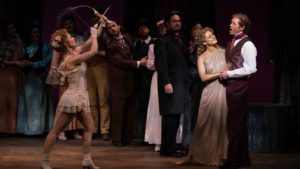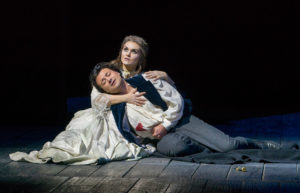VIEWPOINTS – LUCIA DI LAMMERMOOR & IL PIGMALIONE/PIGMALION: The Met and City Opera synergistically counterpoint each other
- By drediman
- March 29, 2018
- No Comments
I had questioned the resuscitation of New York City Opera when they announced that a traditional production of Puccini’s war horse Tosca would be the vehicle for their return. However, since then, City Opera has proven to be a fascinating shape-shifting operation, producing either newer or more obscure works of various scales and venues – albeit to admittedly varying results. This mandate fills a role that the mammoth Metropolitan Opera continues to shy away from, creating a valuable, synergistic counterpoint between the two arts organization that only benefits opera as an art form and us fans. As a case in point, this past weekend, I caught two opera productions, one from each company.

The company of New York City Opera’s production of “Il Pigmalione/Pigmalion” at the Gerald W. Lynch Theater.
First up was City Opera’s double bill Il Pigmalione/Pigmalion (RECOMMENDED) by Donizetti and Rameau, respectively, at the Gerald W. Lynch Theater. It’s rare to see either operas performed these days, and I don’t think these two one acts have ever been bundled into single program, at least in New York. Both operas are inspired by the same source – the Greek myth of Pygmalion, a sculptor who beckons the gods to breathe life into a statue of a woman and falls in love with it. The City Opera production – scrappily directed and choreographed by Richard Stafford – which briefly ran for just three performances, was a sturdy, earnest affair. Despite following very similar dramatic trajectories, these operas are in fact vastly different from each other. Donizetti’s bitesized bel canto Il Pimalione highlights the sculptor’s angst and passion, while Rameau’s more leisurely baroque Pigmalion celebrates the symmetry and harmony of ideal love through a harmonic fusion of music and dance. The music-making was at least competent all-around. Particular kudos to young Polish tenor Piotr Buszewski in the title role of Donizetti’s compact piece; his is a bright, ringing instrument and he exuded natural dramatic instincts and presence onstage. I’d also like to commend conductor Gil Rose for being able to command both styles of opera, back-to-back, in the acoustically intimate Lynch Theater.

Olga Peretyatko-Mariotti and Vittorio Grigolo in Donizetti’s “Lucia di Lammermoor” at The Metropolitan Opera. PHOTO CREDIT – Richard Termine
The next day, I found myself at the opening night performance of the revival of Mary Zimmerman’s atmospheric, large-scale production of Lucia di Lammermoor (RECOMMENDED), one of Donizetti’s masterworks and a staple of the operatic repertoire. In the title role, soprano Olga Peretyatko-Mariotti was compelling as a young woman who is compelled by love into madness and murder. Ms. Peretyatko-Mariotti possesses both the glamour of her Russian colleague, superstar Anna Netrebko, as well as the vocal discipline of a serious artist. She’s definitely one to watch as her career unfolds. As Lucia’s love interest Edgardo, popular Italian tenor Vittorio Grigolo gave a full throttle performance (as usual), vocally and dramatically, to woefully uneven effect. Over the years, his voice has darkened a little bit, turning his ardent – almost careless – outbursts less aesthetically appealing; this was particularly apparent this time around. Still, there were moments when he thrilled, particularly the conclusion of Act 2, in ways only Vittorio can. The rest of the principal cast, featuring Italian baritone Massimo Cavalletti and Ukranian bass Vitalij Kowaljow, was excellent. The Met Orchestra played an exciting account of the Donizetti score under the baton of Roberto Abbado. The Met Chorus sounded pretty glorious, too.
IL PIGMALIONE/PIGMALION
Opera
New York City Opera at the Gerald W. Lynch Theater
2 hours (with one intermission)
Closed
LUCIA DI LAMMERMOOR
Opera
The Metropolitan Opera
3 hours, 30 minutes (with one intermission)
In repertory through May 10

 Copyright © 2024
Copyright © 2024
Leave a Reply